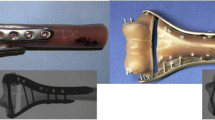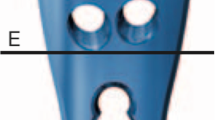Abstract
Locked plating attempts to improve mechanical stability via better anchorage of the screws in the bone. In 22 paired osteoporotic humeri an AO/ASIF 11-B 1 fracture was created. Locked and conventional plating using the same device of the latest generation was performed. Torsional loading around three axes (x = varus/valgus, y = flexion/extension, z = axial rotation) with an increasing moment (2, 3.5, 5 and 7.5 N·m) was applied. Interfragmentary motion within the locked group was lower for all three axes with higher cumulative survival rates (p < 0.05). The typical mode of failure was loss of fixation in the humeral head occurring earlier in the conventional group. The locking mechanism investigated provides more ultimate strength in an osteoporotic proximal humerus fracture model. Correlation with BMD suggests that this device may especially be suitable for use in osteoporotic bone.






Similar content being viewed by others
References
Koval KJ, Blair B, Takei R et al (1996) Surgical neck fractures of the proximal humerus: a laboratory evaluation of ten fixation techniques. J Trauma 40:778–783
Lind T, Kroner TK, Jensen J (1989) The epidemiology of fractures of the proximal humerus. Arch Orthop Trauma Surg 108:285–287
Palvanen M, Kannus P, Niemi S et al (2006) Update in the epidemiology of proximal humeral fractures. Clin Orthop Rel Res 442:87–92
Rasmussen S, Hvass I, Dalsgaard J et al (1992) Displaced proximal humerus fractures: results of conservative treatment. Br J Accident Surg 23:1–3
Hessmann MH, Hansen WS, Krummenauer F et al (2005) Locked plate fixation and intramedullary nailing for proximal humerus fractures: a biomechanical evaluation. J Trauma 58(6):1194–1201
Kwon BK, Goertzen DJ, O’Brien PJ et al (2002) Biomechanical evaluation of proximal humeral fracture fixation supplemented with calcium phosphate cement. J Bone Joint Surg 84-A:951–961
Cofield RH (1988) Comminuted fractures of the proximal humerus. Clin Orthop 230:49–57
Esser RD (1994) Treatment of three and four part fractures of the proximal humerus with a modified cloverleaf plate. J Orthop Trauma 8:15–22
Fankenhauser F, Boldin C, Schnippinger G et al (2005) A new locking plate for unstable fractures of the proximal humerus. Clin Orthop Relat Res 430:176–181
Lill H, Hepp P, Rose T et al (2004) The angle stable Locking-Proximal-Humerus-Plate (LPHP®) for proximal humeral fractures using a small anterior-lateral-deltoid-splitting-approach-technique and first results. Zentralbl Chir 129:43–48 (in German)
Plecko M, Kraus A (2005) Internal fixation of proximal humerus fractures using the locking proximal humerus plate. Operat Orthop Traumatol 17:25–50 (in German)
Seide K, Triebe J, Faschingbauer M et al (2007) Locked vs. unlocked plate osteosynthesis of the proximal humerus—a biomechanical study. Clin Biomech 22(2):176–182
Chudik SC, Weinhold P, Dahners LE (2003) Fixed-angle plate fixation in simulated fractures of the proximal humerus: a biomechanical study of a new device. J Shoulder Elbow Surg 12(6):578–588
Siffri PC, Peindl RD, Coley ER et al (2006) Biomechanical analysis of blade plate versus locking plate fixation for a proximal humerus fracture: comparison using cadaveric and synthetic humeri. J Orthop Trauma 20(8):547–554
Weinstein DM, Bratton DR, Ciccone WJ et al (2006) Locking plate improves torsional resistance in the stabilization of three part proximal humeral fractures. J Shoulder Elbow Surg 15(2):239–243
Südkamp N, Bayer J, Hepp P et al (2009) Open reduction and internal fixation of proximal humeral fractures with use of the locking proximal humerus plate. Results of a prospective, multicenter, observational study. J Bone Joint Surg 91-A:1320–1328
Solberg BD, Moon CN, Franco DP et al (2009) Surgical treatment of three and four-part proximal humeral fractures. J Bone Joint Surg 91-A:1689–1697
Edwards S, Wilson N, Zhang L et al (2006) Two-part surgical neck fractures of the proximal humerus. A biomechanical evaluation of two fixation techniques. J Bone Joint Surg 88-A:2258–2264
Krischak GD, Augat P, Beck A et al (2007) Biomechanical comparison of two side plate fixation techniques in an unstable intertrochanteric osteotomy model: sliding hip screw and percutaneous compression plate. Clin Biomech 22(10):1112–1118
Röderer G, AbouElsoud M, Gebhard F et al (2007) Minimally-invasive application of the non-contact-bridging plate to the proximal humerus. An anatomical study. J Orthop Trauma 21(9):621–627
Röderer G, Gebhard F, Erhardt J et al (2007) The non-contact bridging plate: a new fixed angle device for the minimally-invasive treatment of fractures of the proximal humerus-technique and preliminary results. Unfallchirurg 110(6):505–512 (in German)
Wilke HJ, Claes L, Schmitt H et al (1994) A universal spine tester for in vitro experiments with muscle force simulation. Eur Spine J 3(2):91–97
Diederichs G, Korner J, Goldhahn J et al (2006) Assessment of bone quality in the proximal humerus by measurement of the contralateral site: a cadaveric analyze. Arch Orthop Trauma Surg 126(2):93–100
Tingart MJ, Bouxsein ML, Zurakowski D et al (2003) Three-dimensional distribution of bone density in the proximal humerus. Calcif Tissue Int 73(6):531–536
Erhardt JB, Röderer G, Grob K et al (2009) Early results in the treatment of proximal humeral fractures with a polyaxial locking plate. Arch Orthop Trauma Surg 129(10):1367–1374
Bergmann G, Graichen F, Bender A et al (2006) In vivo glenohumeral contact forces—measurements in the first patient 7 months postoperatively. J Biomech 40(10):2139–2145
Agueldo J, Schürmann M, Stahel P et al (2007) Analysis of efficacy and failure in proximal humerus fractures treated with locking plate. J Orthop Trauma 21(10):676–681
Acknowledgments
The authors would like to express their gratitude to Mrs. Karin Werner for expert technical assistance in performing the experiment.
Conflict of interest
The study was sponsored with a grant from Zimmer Inc. The study sponsor played no role in designing the study, in the collection, analysis and interpretation of data, in writing the manuscript or in the decision to submit the manuscript for publication.
Author information
Authors and Affiliations
Corresponding author
Rights and permissions
About this article
Cite this article
Röderer, G., Gebhard, F., Krischak, G. et al. Biomechanical in vitro assessment of fixed angle plating using a new concept of locking for the treatment of osteoporotic proximal humerus fractures. International Orthopaedics (SICOT) 35, 535–541 (2011). https://doi.org/10.1007/s00264-010-1021-9
Received:
Revised:
Accepted:
Published:
Issue Date:
DOI: https://doi.org/10.1007/s00264-010-1021-9




